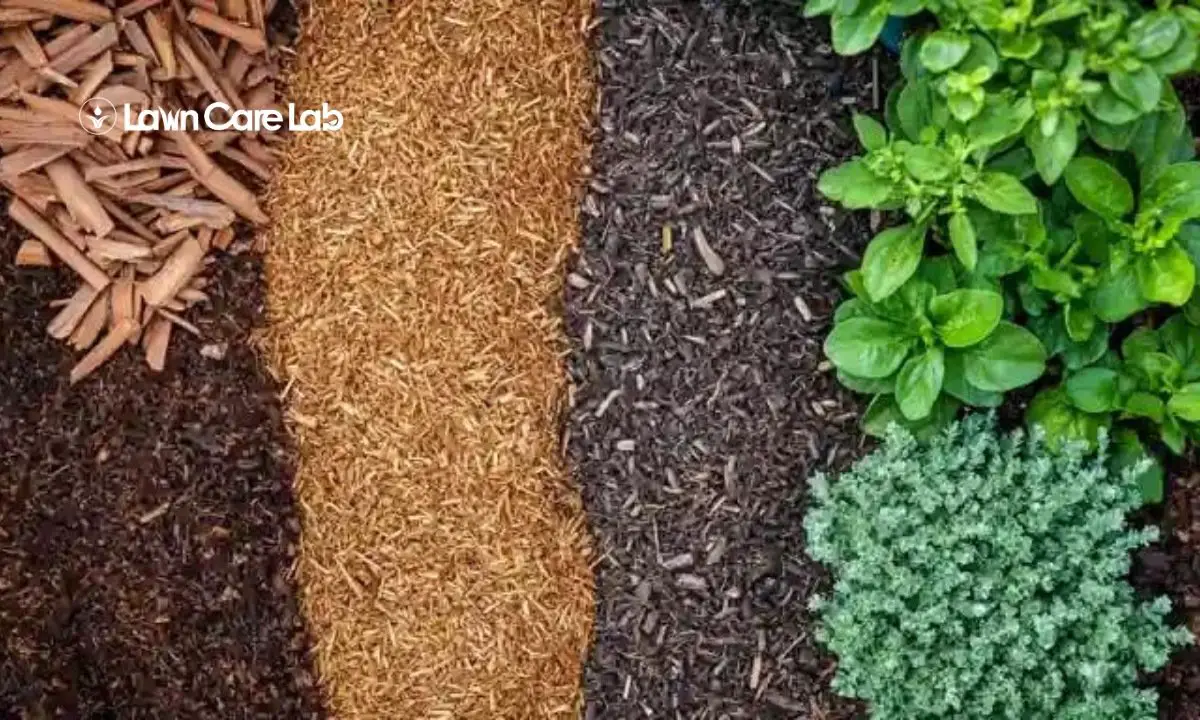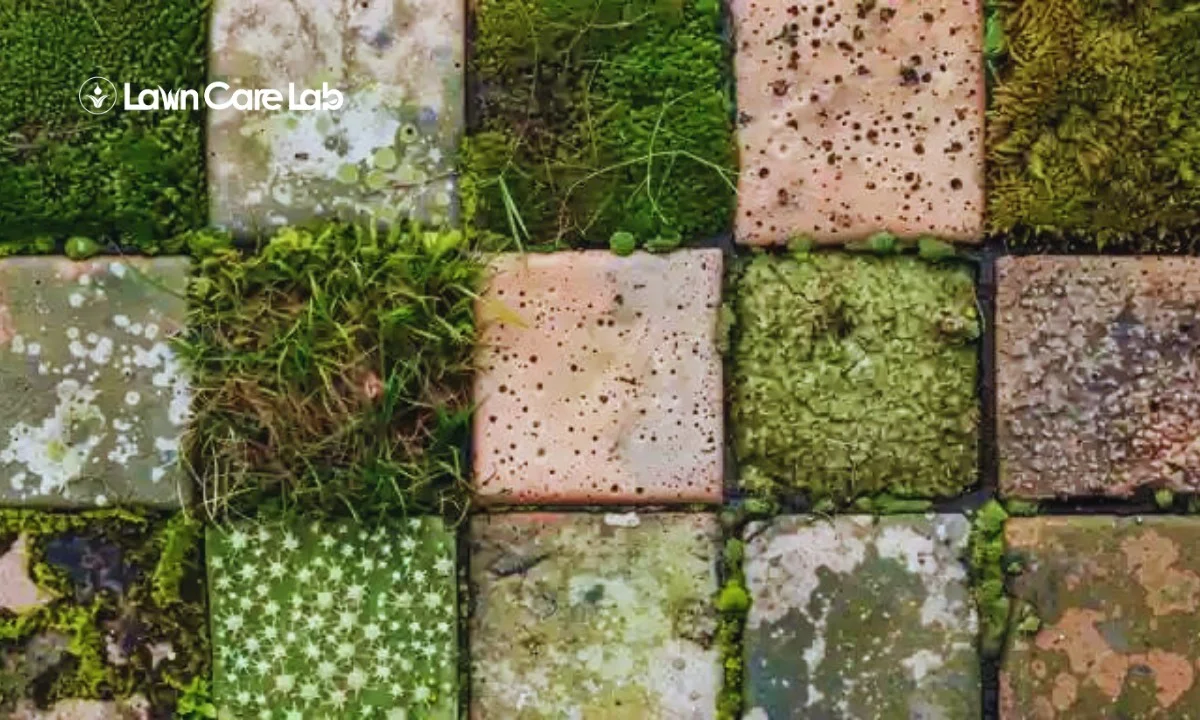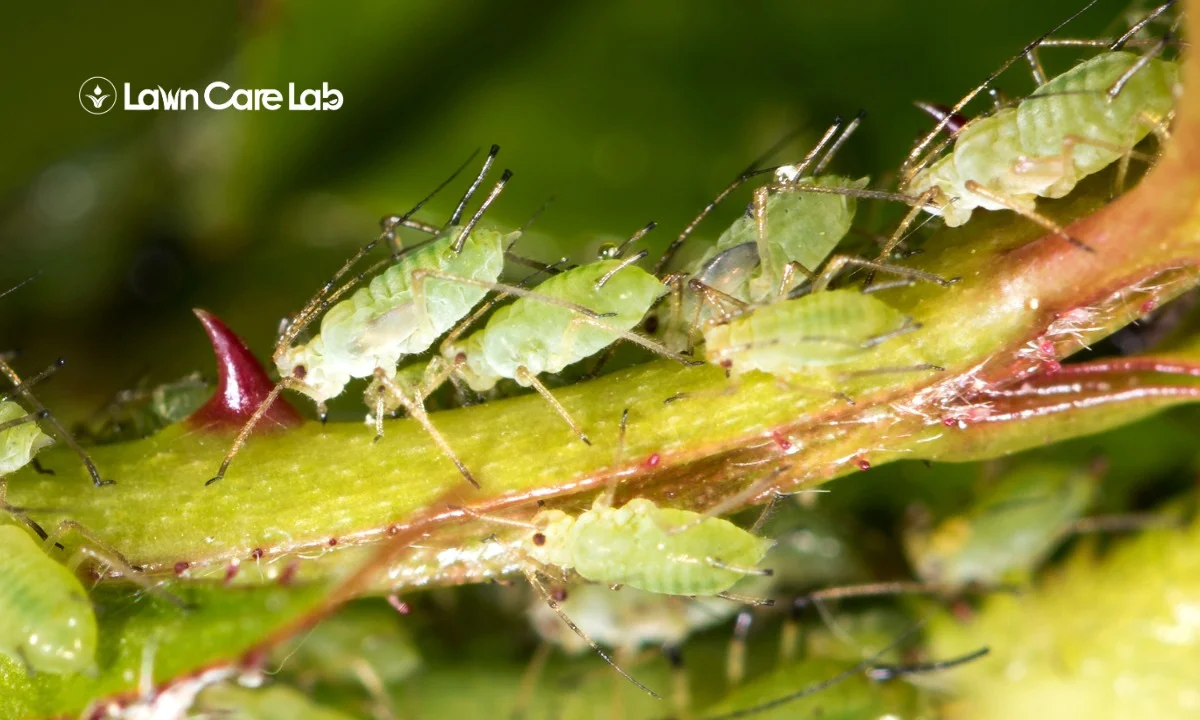Mulch plays a crucial role in gardening, offering many benefits that significantly enhance your garden’s health and appearance. As a protective layer spread over the soil, mulch serves several vital functions, including moisture retention, weed suppression, and soil temperature regulation.
Whether you opt for organic materials like wood chips and straw or inorganic options such as gravel and rubber, each type of mulch brings unique advantages tailored to different gardening needs. This article will explore the benefits of different types of mulch and how to apply them effectively.
By understanding and utilizing the right type of mulch, you can create a thriving, low-maintenance garden that remains lush and vibrant throughout the seasons.
From enriching the soil with organic matter to providing durable, low-maintenance coverage with inorganic options, mulching is an essential practice that every gardener should master.
Table of Contents
Importance of Mulch in Gardening
Mulch is essential in gardening as it improves soil health and enhances the garden’s appearance while promoting plant growth and longevity.

Mulch keeps the soil moist, especially when it’s dry, and stops weeds from growing, which can steal nutrients from your plants.
It also protects plant roots from very hot or cold weather by acting as an insulator.
Plus, mulch prevents soil from washing away, which keeps your garden neat and protects it from the weather.
Using mulch means you’ll have less work to do in your garden, and it will stay looking nice.
Organic Mulch
Organic mulch in your garden offers several advantages. It helps control weeds, keeps soil moisture locked in, and improves soil health.
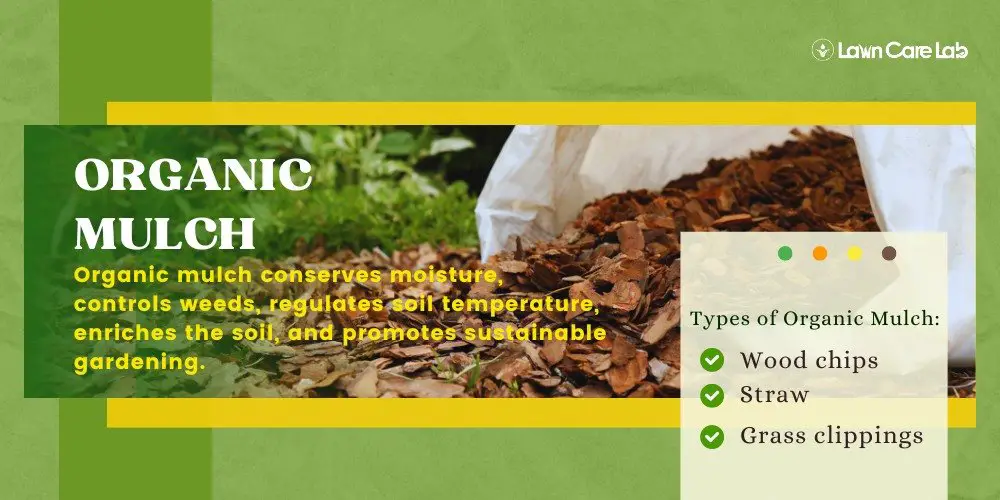
Different types, like shredded bark, straw, and grass clippings, offer specific benefits such as insulating plant roots, preventing soil splashing, and adding essential nutrients back into the soil.
Benefits of Organic Mulch
Organic mulch isn’t only good for your garden because it helps keep the soil moist, which means you don’t have to water as often, but it also brings several other advantages.
Firstly, it helps control weeds. By covering the soil, organic mulch blocks sunlight from reaching weed seeds, preventing them from growing. This saves you time as you won’t have to weed as often.
Secondly, it helps regulate soil temperature. The mulch acts like a blanket, protecting roots from extreme temperatures, whether hot or cold, which helps your plants grow in a more consistent environment.
Thirdly, it enriches the soil. As organic mulch breaks down, it slowly releases nutrients back into the soil, which nourishes your plants over time.
Lastly, it’s environmentally friendly. Using organic mulch means you’re utilizing biodegradable materials, which helps make your gardening more sustainable.
Types of Organic Mulch
Wood chips, straw, and grass clippings are popular organic mulches, each with distinct advantages for your garden.
Wood chips come from tree branches and trunks. They last a long time and help keep soil warm. As wood chips break down, they gradually enrich the soil with nutrients, which is good for plant roots.
Straw, made from the dried stalks of cereal plants like wheat, is inexpensive and great for keeping soil moist and weed-free. At the end of the growing season, straw can be easily worked into the soil to make it better.
Grass clippings, which you get from cutting the lawn, add a lot of nitrogen to the soil. This helps plants grow strong because they’ve a steady supply of nutrients.
Inorganic Mulch
When selecting mulch for your garden, inorganic options such as stone, rubber, and landscape fabric offer durability, low maintenance, and effective weed suppression.
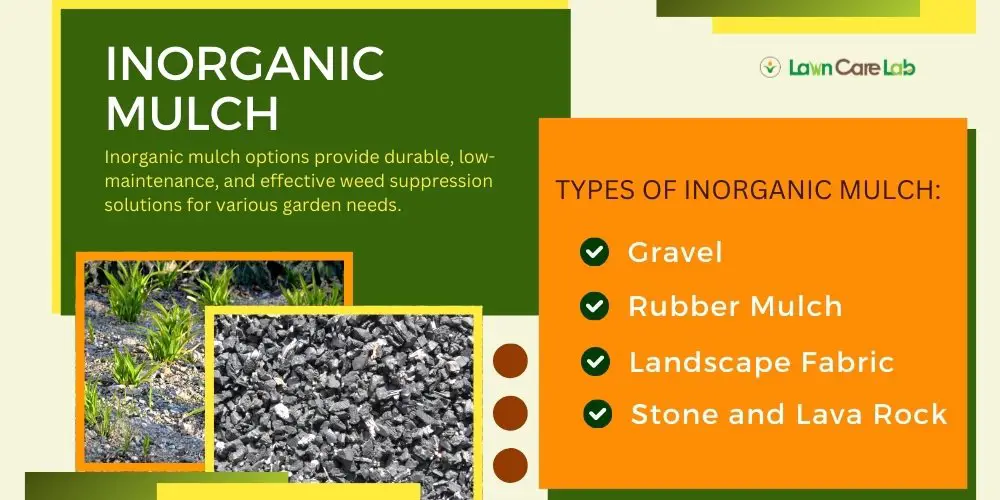
Stone mulch is ideal for decorative purposes and soil cooling, while rubber mulch, made from recycled tires, is perfect for high-traffic areas like playgrounds due to its cushioning properties.
Landscape fabric is a versatile underlayer that blocks weeds while allowing water and air to reach the soil.
Benefits of Inorganic Mulch
Inorganic mulches are a practical choice for maintaining a visually appealing garden with minimal effort. Their key advantages include:
- Durability: Long-lasting, requiring infrequent replacement.
- Weed Suppression: Effectively prevents weed growth, reducing maintenance.
- Aesthetic Appeal: Provides a neat, consistent appearance year-round.
- Low Maintenance: Saves time and effort, allowing more enjoyment of your garden.
Opting for inorganic mulch offers a straightforward and efficient way to enhance your garden’s beauty while minimizing upkeep.
Types of Inorganic Mulch
Both gravel and rubber mulch are excellent for combining functionality with aesthetics, making them ideal for creating safe, attractive, and low-maintenance outdoor environments.
- Gravel: Available in various sizes, colors, and textures, gravel is perfect for high-traffic areas, offering stability, longevity, and excellent drainage.
- Rubber Mulch: Made from recycled tires, rubber mulch is a sustainable choice that stays in place, resists compaction, and insulates plant roots, providing year-round protection.
Benefits of Mulch for Plants
Mulching provides several essential benefits that promote healthier plant growth:
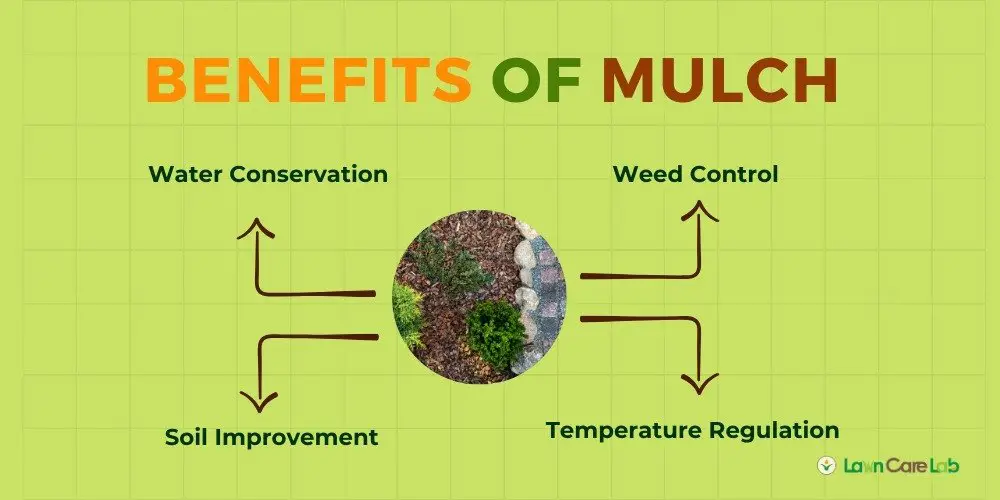
- Water Conservation: Mulch retains soil moisture, reducing the need for frequent watering and ensuring plants receive consistent hydration.
- Weed Control: By blocking sunlight, mulch prevents weeds from sprouting, saving you time on weeding and enhancing your garden’s appearance.
- Soil Improvement: Organic mulches, like wood chips or leaves, decompose over time, enriching the soil with nutrients and supporting robust plant growth.
- Temperature Regulation: Mulch insulates the soil, keeping it cooler in summer and warmer in winter, helping to protect plant roots and maintain a stable growing environment.
For instance, straw mulch is particularly effective in vegetable gardens, offering moisture retention, weed suppression, and soil enrichment as it decomposes.
How to Apply Mulch
Understanding the advantages of mulch, let’s move on to applying it correctly. Begin by preparing your garden soil; this involves pulling out any weeds and leveling bumps or dips in the soil. This step is crucial because it ensures that the mulch layer can function effectively, helping to retain moisture and suppress weeds.
Preparation
Before you lay down mulch, first ensure the soil surface is free from weeds, debris, and old plants to create a clean foundation.
Follow these steps to ensure effective and safe mulching:
- Clear the Area: Start by removing weeds, debris, and old plants from the soil surface to create a clean foundation.
- Level the Soil: Smooth out any bumps or dips in the soil to ensure even mulch coverage.
- Loosen the Soil: Use a rake to gently stir the top layer, improving water and nutrient absorption once the mulch is applied.
- Check Soil Moisture: Ensure the soil is slightly moist; if it’s too dry, it won’t absorb water effectively, even with mulch.
- Trim Nearby Plants: Prune any overhanging branches or nearby plants to prevent interference with even mulch application.
- Wear Safety Gear: Protect your hands with gloves to avoid injury from sharp objects or irritants in the mulch or soil.
Application Techniques
After preparing your garden bed, it’s time to mulch. Spread the mulch evenly across your garden to cover the soil completely. This helps keep the soil protected and stops pests from getting in.
For organic mulches like bark or compost, use a layer that’s about 2-4 inches thick. For inorganic mulches like gravel or rubber, a 1-2 inch layer will do. This thickness is important because it helps keep the soil moist and stops weeds from growing.
Make sure the mulch doesn’t touch the bases of plants or trees, as this can cause them to rot or get sick. Check your mulch regularly to see if it’s getting flat or thin, and add more if needed. This keeps it working well.
Conclusion
Learning how to use mulch effectively can greatly enhance the health and appearance of your garden.
Choose organic mulch like wood chips to enrich soil or inorganic options like stones for long-lasting coverage. Apply a 2-4 inch layer to retain moisture and suppress weeds. Maintain by replenishing mulch annually, ensuring ongoing benefits like moisture retention and temperature control. Always prioritize safety by wearing gloves and using proper tools. Following these tips will help your garden thrive.
By following these essential tips, you can maximize the benefits of mulch, contributing to a thriving and beautiful garden.
Frequently Asked Questions
Can Mulch Attract Pests to My Garden?
How Often Should Mulch Be Replaced?
Is Mulch Safe for Vegetable Gardens?
Can I Use Mulch Around Young Trees?
Does Mulch Type Affect Soil Ph Levels?
- How to Create a Lawn Care Schedule for Southern Climates - October 30, 2024
- How to Use Compost Tea to Boost Lawn Growth and Soil Health - October 23, 2024
- The Best Grasses for Saltwater-Exposed Lawns: Coastal Lawn Care - October 17, 2024

